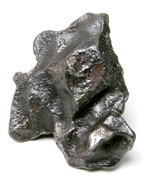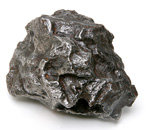
|
Sale 30
Manuscript and Collectibles Auction
| Lot |
Photo |
Description |
Realized |
Lot 1765 |
 |
Rare Oriented Sikhote-Alin. Sikhote-Alin iron-nicket meteorites are from the most recent, major fall of a large meteorite. It occurred at 10:30 AM on February 12, 1947, above the Sikhote-Alin mountains of Siberia. Because this fall was so recent, much detail can be found on some of the meteorites with their complete fussion crust not affected by rusting.
This remarkable 2½ x 2 x 1½ in., 284 gm. specimen is rare and very special in that it shows that it was oriented in its path through the atmosphere, meaning that it did not rotate during its descent, but rather melted in one direction. Flow lines of melted iron flow down the meteorite like wax on a candle. It resembles a volcano with magma flowing down from its peak. Very few of these are found. This metal flow pattern was used by NASA in designing the shape and angles of the nose cone of the space shuttle.
Estimated Value $500 - 1,000.
View details and enlarged photo
| Realized
$489 |
Lot 1766 |
 |
Sikhote-Alin Iron-Nickel Meteorite From Siberia. This is a large 2½ lb., 4 x 2½ x 2 inch meteorite. Most examples of Sikhote-Alin meteorites only weigh 50-100 gms. There are two distinct types of Sikhote-Alin meteorites, one replete with regmaglypts (thumbprints) and the other the shrapnel-type from the enormous explosion that took place several miles up in the earth's atmosphere on Feb. 12, 1947. This unusual meteorite has some characteristics of both types. There are some sharp edges characteristic of the shrapnel type, but also some definite regmaglypts. It has the classic gun-metal color and sits on its natural narrow base. This is a rare opportunity to acquire an unusual example of the most highly sought after iron-nickel meteorite. For domestic shipping, add $20.
Estimated Value $550 - 800.
View details and enlarged photo
| Realized
$575 |
Lot 1767 |
 |
Small Pieces of the Moon and Mars. The rarest of all meteorites are those that originate from the Moon and Mars. Only when extremely large pieces of asteroids explode into their surfaces do a few make it to Earth. Most meteorites are as old as the solar system itself, some 4055 billion years old, but meteorites from the Moon and Mars are younger; the ratio of various isotopes can determine the origin. These 2 x 2mm sections were cut, polished and placed in a custom frame measuring 13 x 7 in., with a Certificate of Authority giving the origin of each piece. The complete lunar meteorite weighed barely 1 ounce and was found on April 22, 2001 in the Sahara Desert of Oman. It was certified by the Institute of Planetary Physics, UCLA. The complete Martian meteorite weighed just over 40 pounds and was found on January 24, 2000, also in the Sahara Desert of Oman. It was certified by the Vernadsky Institute, Russian Academy of Sciences. Ready for display. Allow $15 for shipping.
Estimated Value $375 - 575.
View details and enlarged photo
| Realized
$276 |
Lot 1768 |
 |
Whole Stony Meteorite From Morocco. Although most meteorites that fall to earth are stony meteorites, whole, intact, stony meteorites are rarely encountered. Most finds consist of a single meteorite, weighing a few pounds at most. Meteorites are named after the city or region where they fall, and collector demand is so high to own a piece of a named fall that the meteorite found is usually cut up and polished to satisfy this demand. Also, the fusion crust (the brown to black thin outer layer burned from the intense heat of passage through the atmosphere) quickly weathers away and thus makes it difficult to identify a meteorite.
This large (for a stony) meteorite measures 5 in. long x 5¼ in. wide x 3 in. high and weighs a hefty 4½ pounds. It was found in 2000 in the Sahara desert near Boudnib, Morocco in the Hamada region. The shape and color are exquisite, with some thumb prints (regmaglypts) and their dark brown fusion crust over most of the upper and side surface. The bottom has most of the fusion crust partially worn away by the desert wind, but has a 1 in. x 1 in. section cut and polished to show both sectioned chondrules and flecks of iron. Chondrules are small, near spherical silicate grains that were part of the interstellar cloud that condensed to form the planets, moon and asteroids. Allow $20 for shipping.
Estimated Value $1,300 - 2,200.
View details and enlarged photo
| Realized
$1,265 |
|
|